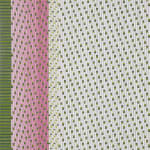Andrea Higgins: The Presidents’ Wives
Once, during the Reagan administration, when Barbara Bush turned up for a luncheon in the First Lady’s trademark color, Mrs. Reagan shrieked, “Never wear red again as long as I live in this house!”
–Anne Slowey, Elle, quoting Lesley Stahl’s book Reporting Live
Every recent First Lady with the notable exception of Barbara Bush leaves office thinner and more glamorous than when she arrived. The process is as inevitable as it is painful. Only Barbara Bush dared to capitalize on her grandmotherly image, and the public loved her for it. Laura’s transition may not be so easily accomplished. The purple plaid suit that she wore to her first meeting with Hillary Clinton was roundly ridiculed.”
–Eleanor Clift, “Laura and Her Creation,” Georgetowner, January 25, 2001
Andrea Higgins makes paintings that are magnifications of fabric swatches. Moire, herringbone, houndstooth or plaid — each fiber is represented by a layering of brushstrokes. The repetition of marks, like weaving of threads, creates patterns that are both minimal and dynamic. The paintings are elegant abstractions, yet each familiar fabric carries associations for the individual viewer.
Higgins’ current body of work focuses on the wardrobes of American Presidents’ wives. The clothes these women wear, she postulates, reflect the social climate and political priorities of the administration of which they are a part.
Jacqueline Kennedy utilized her wardrobe to craft an image of glamour and elegance for the Kennedy White House. She recognized that solid colors photograph better than prints, and chose her wardrobe for the powerful new medium of television. Carl Sferrazza Anthony, biographer of first ladies, wrote that Jackie became a “symbol of the liberation from the notion that America had to be bourgeois.”
Nancy Reagan was determined to return a sense of style and formality to the presidency, which she believed had been neglected during the Carter administration. Commentators saw her expensive and flamboyant clothes as a reflection of the ebullient 1980’s “Trickle-down Economics.”
Higgins’ paintings uncannily represent the women and politics of the presidential term they reference. “Laura” is the rendering of a purple suit worn by Laura Bush as she was welcomed to the White House by Hillary Rodham Clinton (wearing a signature black pantsuit). Higgins found a photograph of the women shaking hands. The caption reads, “After 2 terms in the White House, Hillary Clinton’s black power suit is surrendering to Laura Bush’s colorful tweeds.”
To our eyes, which are trained to spot the faces of powerful men and women in a roomful of black and grey suits, Mrs. Bush’s patterned outfits look like castoffs from the wardrobe of Queen Elizabeth II.
(T)here is a sort of humility and innocence in Mrs. Bush’s style that tends to ward off harsh criticism. Unlike Nancy Reagan’s wardrobe, her clothes are not screaming for attention. Nor does her dowdiness cry out with moral righteousness, as was the case when Rosalyn Carter pulled an old dress out of her closet for her husband’s inaugural ball.
I’m beginning to think that the Bush style — exemplified by the new first lady’s dowdy wardrobe — is perhaps appropriate to our times. It is the fashion equivalent of political centrism. It satisfies a growing nostalgia for a simpler time in American life.”
— Sara Fritz, “A Style of Dress and Politics,” St. Petersburg Times, January 15, 2001.

